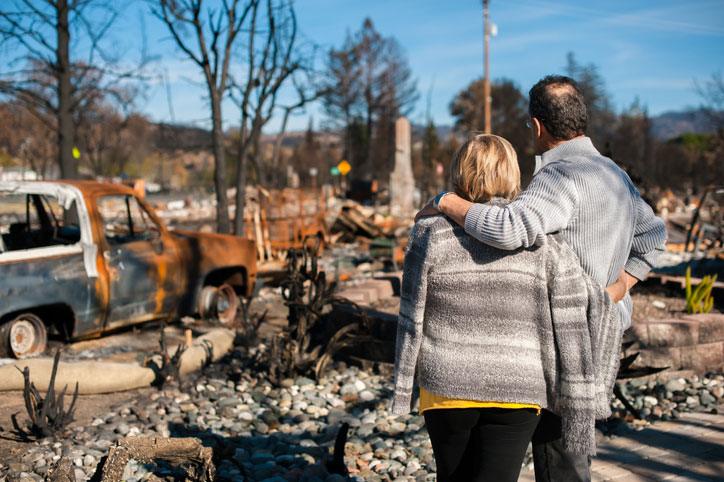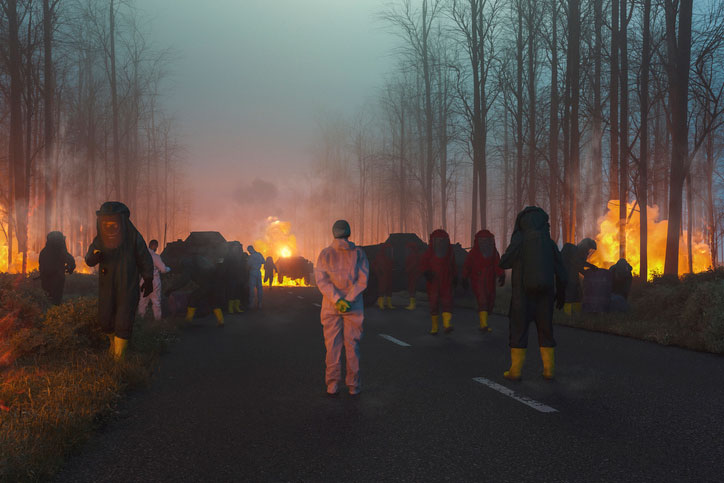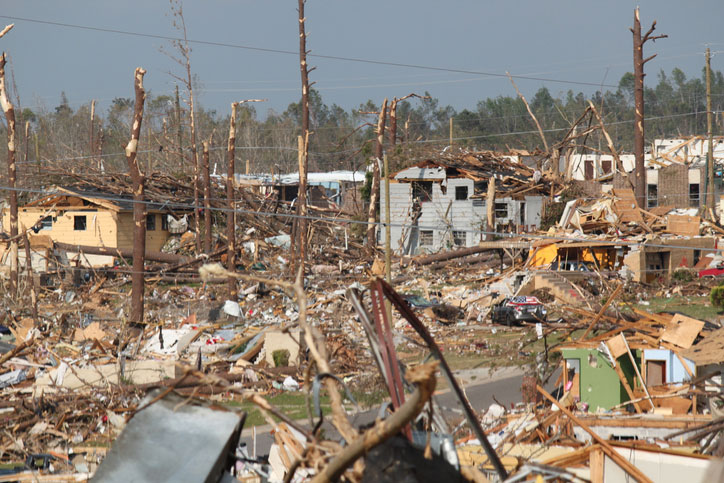It was unseasonably warm across Kentucky in early December 2021 as dusk quickly turned into night. In Mayfield, meteorologists interrupted programming to alert residents that because of the precipitous drop in temperatures, winds had rapidly begun to increase in speed and severity. Tornado warnings flashed on TV networks and radio broadcasts across the region. But in Mayfield, Huda Alubahi rushed into action and huddled in the bathroom closet of her home with her two young sons. As the tornadoes touched down all over the area, the house collapsed onto all three of them.
Buried underneath the rubble, Alubahi remembers hearing her one-year-old son crying but being unable to move her arms to comfort him. She was trapped. Fortunately, a group of rescuers managed to find her hand sticking out of the debris. They were able to pull her out and save her and her youngest son. Her three-year-old son Jha’lil, however, sustained fatal injuries.
Because of this unprecedented level of devastation, several other families found themselves in similar situations. In total, 80 people in Kentucky died from the tornadoes. 15,000 buildings and trailers were destroyed, totaling more than $3.5 billion in damages.
The loss that people experience in these kinds of situations is unimaginable. The grief over the loss of loved ones, homes, and communities is palpable as victims scramble to pick up the pieces of their lives. To help those affected by these catastrophic events, practitioners who are trained in disaster management social work intervene to offer unique, life-saving support. As trained professionals, social workers who specialize in responding to catastrophic events focus on disaster planning, management, relief, and recovery. As a result of successful disaster management social work practices, individuals and community victims are better able to receive the immediate and long-term support they need to start rebuilding.
- Disaster Relief Social Work: An Overview
- The Difference between Emergency Response and Disaster Management Social Workers
- A Social Worker’s Role in Disaster Relief
- Disaster Management Social Work Job Description
- Disaster Management Social Work Career Outlook
- How to Become a Social Worker in Disaster Management
Disaster Relief Social Work: An Overview
Before focusing on what disaster management means in the context of social work, it’s important to understand what constitutes a disaster. According to social work scholar Michael J. Zakour of Tulane University, disaster as a concept can be defined “primarily through social disruption and collective stress.”
Zakour goes on to give this definition more context, stating that “disasters are seen as a type of collective stress situation, in which many individuals fail to have their needs met through societal processes.” When both social structures and economic supports that serve as the foundation of people’s lives are immediately, unrecognizably stripped away, community members and individuals will need specific kinds of aid.
To help connect survivors of catastrophes to the resources they need, disaster relief social workers must intervene both proactively and reactively in ways that ultimately prioritize victims’ needs.
After disasters occur, depending on the magnitude and scale of the event, communities of people are often displaced to a traumatizing degree. From natural disasters like floods, tornadoes, hurricanes, earthquakes, landslides, droughts, wildfires, and severe thunderstorms, victims’ worlds are turned upside down. Much the same can be said of human-caused catastrophes, too.

And as professionals move in to provide immediate support, victims must grapple with the loss of family members and loved ones, of their homes, of their jobs, and of their communities. The best kind of help that emergency response social workers can provide to victims in the immediate aftermath of a disaster is through offering basic necessities: food, clean water, and shelter.
Because the damage that disasters wreak is multifaceted across emotional, physical, economic, and social levels, disaster relief social workers play a vital role in providing necessary resources to victims. According to the Federal Emergency Management Agency (FEMA), social workers play a vital role in helping with “recovery efforts in the restoration of public health, health care and social services networks to promote the resilience, health, and well-being of affected individuals and communities” Through these central functions, disaster management social workers engage at practically every stage of a natural disaster.

The Difference between Emergency Response and Disaster Management Social Workers
While disaster management social workers are trained and equipped to provide life-saving resources to victims, they should not be confused with emergency responders. While disaster management as a field is inclusive of so many important roles to help individuals, communities, and the environment, both social workers and emergency responders may share some similar tasks but overall perform different responsibilities.
For one, emergency responders in natural disaster situations are specifically trained to engage in sometimes high-risk situations to rescue victims to safety. Across terrains that could include flooded, deep waters or forests that are on fire, emergency responders must at times put their own lives at risk to save people.
Emergency responders, which can include volunteer local residents, first responders, firefighters, public health professionals, and law enforcement officers, ultimately act to provide search and rescue services and first aid and medical resources.

Through this approach, emergency responders are able to connect victims of natural disasters with the direct aid they need in the immediate aftermath. Separately, emergency response officials are also proactive about disaster relief in specific, pragmatic ways.
According to the Department of Homeland Security (DHS), emergency responders develop plans for disasters that could affect their communities. Depending on the disaster, the DHS recommends that emergency responders develop protective frameworks that include:
- Evacuation
- Shelter-in-place
- Lockdown
- Sheltering
On the other hand, disaster management social workers operate differently to accomplish different objectives. For the most part, these kinds of social work practitioners will not engage in the life-threatening activities that emergency and first responders must perform. Instead, social workers intervene before, during, and after a disaster to ensure that victims receive the support they need to begin rebuilding their lives.
A Social Worker’s Role in Disaster Relief
Importantly, social workers in this field must be able to respond to both natural and human-driven disasters. These kinds of disasters can encompass events as disparate as violent conflicts between nations or states, volcanic eruptions, nuclear power plant meltdowns, and blizzards.
While each of these kinds of events pose unique challenges with unique consequences, social workers in disaster management are specifically trained with the expectation that victims of these events will need unique support. These kinds of practitioners can help meet these expectations by using specific victim support strategies before, during, and after a disaster has occurred.
How Social Workers Prepare for Disaster Management
Proactively preparing for a disaster of any kind can help save people’s lives and restore communities. In this capacity, disaster management social workers dedicate a sizable portion of their bandwidth to developing plans and responses to ensure victims receive the support they need after a disaster.
Because victims of disaster experience extreme levels of disruption in their lives, social workers in disaster management must be in advanced communication with organizations that offer support in housing, food relief, career services, and grief and mental health counseling.
By expecting the worst and developing plans to connect victims with the agencies who can best meet their needs, these social work practitioners are able to offer life-saving solutions and outcomes.

One of the most effective strategies that emergency response social workers can take on when planning for a disaster is circulating information to potentially affected, vulnerable communities. When people are better informed on what to expect, especially through an event as life-altering as a disaster, social workers can more successfully intervene to provide necessary resources and guidance.
Specifically, social workers can help draft equitable and safe evacuation, sheltering, and lockdown plans to best aid vulnerable communities and individuals. And as these plans are circulated to the people who will be directly affected by unpredictable disasters, the same people and communities will have a much greater chance of survival.
A Social Worker’s Response During a Disaster
While a comprehensive disaster response strategy will help inform effective social work decision making, there’s no way to prepare fully for the demands that a catastrophe will present. Even though social workers must prepare a high-level, overarching plan to help as many people as possible, it’s necessary to understand that disasters are fluid, largely unpredictable situations.
Because of this fact, social workers must remain flexible as they aim to support victims of disasters in real time. By coordinating immediately with medical practitioners, housing shelters, food banks, and community centers, disaster management social workers can connect survivors with the relief they’ll need.
Social workers won’t typically be placed in dangerous situations to provide support to survivors, but they will likely be on the ground to offer outreach to those who need it. Through this responsibility, practitioners will be able to respond to victims’ needs more effectively and proactively.
Disasters will inflict different kinds of trauma on survivors. Because social workers will be specifically trained to respond to mental health emergencies, disaster management practitioners will be best suited to connect survivors with necessary counseling services in a more timely manner.

By providing survivors with the mental health support they need during and immediately after a disaster, social workers are better able to ensure that victims can adopt robust coping strategies. While much of the therapeutic services and mental health counseling will have to be delivered gradually and consistently after the catastrophic event, social workers can still intervene directly to provide immediate, responsive care.
Social Workers Build on a Foundation of Support After a Disaster
Economically and socially vulnerable populations are at greater risk both during and after a catastrophic event. According to FEMA, “disadvantaged households, such as low-wealth families, children and older adults, people with disabilities, and racial and ethnic minorities, suffer disproportionately during major disasters, be they hurricanes, floods, or industrial accidents.”
Because of these overarching, pre-existing problems, social workers must apply innovative problem-solving techniques to best support the people who need it.
The Minnesota Department of Health has come to a similar conclusion, stating that economically disadvantaged communities face significant challenges in receiving medical attention, shelter, and access to food services after a disaster. This logic unfortunately makes sense, where already disenfranchised and marginalized communities and individuals will struggle much more severely – and immediately – than others who have greater means.

Through the upfront knowledge of these circumstances, disaster management social workers can collaborate with governmental and humanitarian organizations to deliver ongoing aid.
In the aftermath of a catastrophic event, social work practitioners move into a more recovery-focused phase. During this time, social workers engage in the following activities.
Direct Outreach
Social workers in the wake of a disaster must find ways to connect survivors with the help they need. In this respect, practitioners must work diligently to make sure that victims of a disaster have and gain access to life-saving support. This kind of strategy can be conducted on the ground, directly with community leaders, with individuals, or across digital means. Additionally, many victims after a disaster may not understand that they need or are eligible for relief support. Social workers can help bridge that gap by informing victims of the resources they may need.
Case Management
In the aftermath of a disaster, social workers specialized in the field will typically see a stark increase in the number of individual cases they must address. Here, social workers will have to practice advanced organizational skills as they respond to individuals’ needs.
Mental Health Counseling
The trauma associated with surviving a disaster can seem insurmountable for victims. Outside of making food, shelter, and other relief services available to survivors, disaster management social workers also step in to offer necessary counseling services. As trained mental health practitioners, social workers are uniquely equipped to offer emotional, psychological, and even clinical support. Because different traumas and triggers are associated with different kinds of disasters, social workers can apply specific tactics to ensure survivors receive the care they individually need.
Establish Support Networks
At the same time that individuals’ lives are turned upside down after a disaster, communities as a whole also face tremendous challenges. And when people don’t feel connected to a community or to other community members, recovering from a tragedy like a catastrophic event can seem nearly impossible. Social workers can help restore communities when they connect people to the support networks they may be familiar with. The recovery process will prove much more sustainable and much more effective when social workers are able to restore community-based connections.
Victim Advocacy
After a disaster, affected communities and places can receive greater attention from media sources. But after the dust settles and news cycles move on, communities are still left reeling and often disconnected. In this regard, social workers can continue to advocate outwardly for ongoing, continued support for survivors. Both on an individual and community level, social workers engage with policymakers, agencies, and organizations to advocate for greater levels of aid for those who need it.
Disaster Management Social Work Job Description
As practitioners who specialize in responding to catastrophic events, both human-caused and natural, disaster management social workers are trained specifically to promote individual- and community-based restoration, redevelopment, and revitalization.
Disaster management social workers ultimately drive an emphasis on community reparation balanced with public health outreach.
Specifically, the role of social workers in disaster management encompasses the following:
- Rehabilitating survivors with the support they require
- Creating comprehensive disaster response strategies
- Communicating disaster response plan information to vulnerable populations and communities
- Performing outreach campaigns during and after catastrophic events
- Coordinating with appropriate organizations, agencies, and governmental bodies to reduce emotional, psychological, physical, and medical suffering on survivors
- Advocating for victim relief throughout the course of a disaster
- Intervening with public health best practices to ensure victims receive the support they need
- Connecting survivors with the necessary relief and recovery resources

Social work and disaster management intersect to provide aid to everyone affected by a disaster, no matter the size or scale of the event. Even though media attention quickly turns to a focus on cleanup and the influx of food and supplies, social workers often act as unsung heroes as they assist victims in coping with the trauma they have just endured.
Disaster Management Social Work Career Outlook
In the field of disaster management, social workers are often compensated for the difficult work they must perform as they provide aid to victims round the clock. According to the Bureau of Labor Statistics, social workers currently earn an average yearly salary of $63,010 Through 2030, social worker positions are expected to grow by 12%.
As social workers successfully help different populations and communities navigate specific disasters, different leadership positions will become available. Specifically, emergency management directors, tasked with interdisciplinary and multi-pronged responsibilities, oversee the procedural responses that help save lives during and after catastrophic events. These positions earn an average yearly salary of $84,800 and these kinds of leadership positions are expected to grow by 6% through 2030, according to the Bureau of Labor Statistics.
How to Become a Social Worker in Disaster Management
There are many paths into the field of social work in disaster management. Probably the most efficient way to enter the field is by getting a bachelor’s and/or Master of Social Work from an accredited institution. By learning from experienced faculty with practice in the field, you will be able to adopt the most effective measures in supporting victims of disasters and catastrophic events of all sizes.
Many social work programs across the country and in online spaces are excellent entry points into a growing industry. Disaster management social worker roles are growing in demand as unexpected, climate change-linked disasters are becoming more frequent across the world. Separately, crisis and trauma social workers, who share many of the same responsibilities as disaster management social workers, are becoming increasingly needed in vulnerable, at-risk communities. Learn more about these unique social work opportunities and begin your journey into community-level, emergency response support today.
2021 US Bureau of Labor Statistics salary and employment figures for Social workers (all, other) and Emergency Management Directors reflect national data, not school-specific information. Conditions in your area may vary. Data accessed March 2023.











